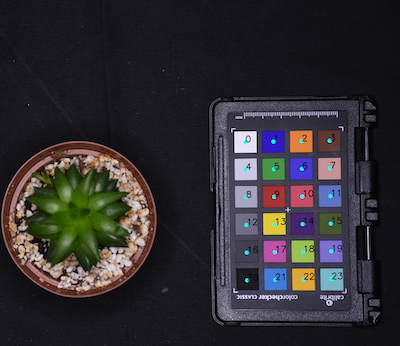Automatically Detect a Color Card¶
Automatically detects a color card and creates a labeled mask.
plantcv.transform.detect_color_card(rgb_img, label=None, **kwargs)
returns labeled_mask
- Parameters
- rgb_img - Input RGB image data containing a color card.
- label - Optional label parameter, modifies the variable name of observations recorded. (default =
pcv.params.sample_label) - **kwargs - Other keyword arguments passed to
cv2.adaptiveThresholdandcv2.circle.- adaptive_method - Adaptive threhold method. 0 (mean) or 1 (Gaussian) (default = 1).
- block_size - Size of a pixel neighborhood that is used to calculate a threshold value (default = 51). We suggest using 127 if using
adaptive_method=0. - radius - Radius of circle to make the color card labeled mask (default = 20).
- min_size - Minimum chip size for filtering objects after edge detection (default = 1000)
- Returns
- labeled_mask - Labeled color card mask (useful downstream of this step in
pcv.transform.get_color_matrixandpcv.transform.correct_color)
- labeled_mask - Labeled color card mask (useful downstream of this step in
- Example use:
Note
Color chip size can only be used reasonably as a scaling factor (converting pixels to a known real world scale like cms) only when the color card is on a consistent plane relative to the subject AND the color card is parallel to the camera. There are a few important assumptions that must be met in order to automatically detect color cards:
- There is only one color card in the image.
- Color card should be 4x6 (like an X-Rite ColorChecker Passport Photo).
from plantcv import plantcv as pcv
rgb_img, path, filename = pcv.readimage("target_img.png")
cc_mask = pcv.transform.detect_color_card(rgb_img=rgb_img)
avg_chip_size = pcv.outputs.observations['default']['median_color_chip_size']['value']
avg_chip_w = pcv.outputs.observations['default']['median_color_chip_width']['value']
avg_chip_h = pcv.outputs.observations['default']['median_color_chip_height']['value']
Image automatically detected and masked

Source Code: Here